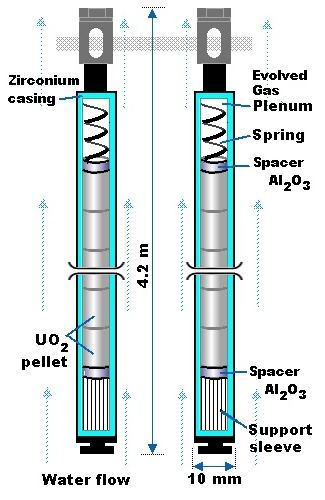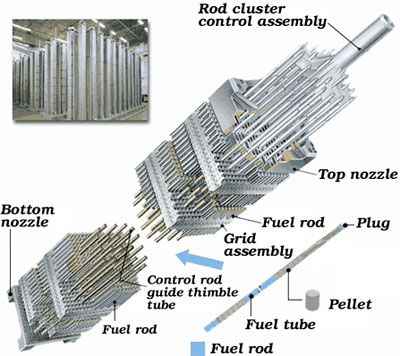Fuel rod
A fuel in nuclear reactors is a filled with the intended nuclear fission fuel tube. The nuclear fuel usually consists of sintered pellets (pellets ) made of uranium dioxide or a mixed oxide of uranium dioxide and plutonium dioxide.
"Burn"
The term "burning" is related to the nuclear energy ( " fuel rod ", " fuel element ", etc. ) is used only in the figurative sense, because none of the materials used in this case is subject to a combustion process in the strict sense, ie oxidation.
After some time a fuel assembly is " burned off ", i.e., by the chain reaction, such a proportion of the mass of fuel in the converted cleavage products in that the element can not be efficiently used for power generation. It is then replaced with a fresh item. The used or spent fuel elements are stored to be later supplied to the disposal, the question of the repository is still open. A portion of the spent fuel is reprocessed. Germany and Switzerland do not send more fuel for reprocessing.
Dimensions and arrangement
A single fuel rod has a height of 4.8 m and a diameter of 11 mm, for example in the pressurized water reactor Brokdorf.
Many individual fuel rods are bundled by means of spacers to fuel or fuel cartridges. Depending on the reactor type, these can be executed in round, rectangular, or polygonal plate shape.
Modern designs of fuel assemblies contain -length fuel rods (english part length fuel rods ) to optimize the power distribution in the reactor.
Fuel rod cladding
The fuel rod cladding, called cladding tube is a metal tube surrounding the nuclear fuel. She has, depending on the type of assembly, a wall thickness of about 0.6-0.8 mm. The ducts are filled in a fuel fabrication plant with the fuel pellets. To achieve the highest possible thermal conductivity, the remaining gap between the nuclear fuel and the cladding tube, the gas is helium and is compressed therein, the fuel rod cladding gastight exhaustive.
As material for the cladding tubes, take a substance with a low cross section for neutron capture, so that the chain reaction will be lost as few neutrons. Most, therefore, a very zirconiumreiche alloy such as Zircaloy used. This is similar strong as steel, but is very brittle after overheating.
The fuel rod cladding is supposed to separate and prevent the arising during the nuclear fission fission products enter the coolant the nuclear fuel from the coolant of the reactor. It is thus one of the nested technical barriers to the safest possible retention of the radioactive materials.
Provided that the welds are close and the cladding tube is not otherwise leak, the pipe holding all fission products in the interior thereof. But also arise during normal operation caused by corrosion and radiation damage structural changes in the alloy. Therefore, developing a small part of the cladding tubes cracks, can escape through the gaseous fission products. It is usually radionuclides with mean half-lives, especially isotopes of iodine, xenon and krypton.
Corrosion of Zirkalloyoberflächen in a nuclear reactor is inevitable. Its magnitude is mainly determined by the nature of the material, the cladding tube, and the chemical composition of the surrounding coolant. The thickness of the oxide layer increases with time. The ever- present radiation in the reactor also influences the structure of the cladding material. Corrosion is therefore one of the processes which limit the operating time of the fuel in a reactor to about three to five years.
Core melt accident
Fuel may melt when they are not sufficiently cooled during operation. In this case, other materials melt in the reactor core, it is called a meltdown. This risk is due to the resulting decay heat even with the reactor shut down. Thus, a continuous cooling even after a removal of fuel rods from the reactor core during storage in cooling ponds still necessary for several years to prevent overheating.
Safety criteria
In the Western world is a prerequisite for the granting of an operating license, that the following may be determined by the NRC conditions are fulfilled guaranteed during operation:
- The temperature must not exceed 1200 ° C.
- The thickness of the oxidation layer of the cladding shall not exceed at any point 0.17 times its unoxidized wall thickness.
- The hydrogen release may account for a maximum of 0.01 times the amount that would arise with complete Hüllrohroxidation.
- The geometry of the cladding must not vary so that the cooling can not be ensured.
- The decay heat to dissipate in the long term.









